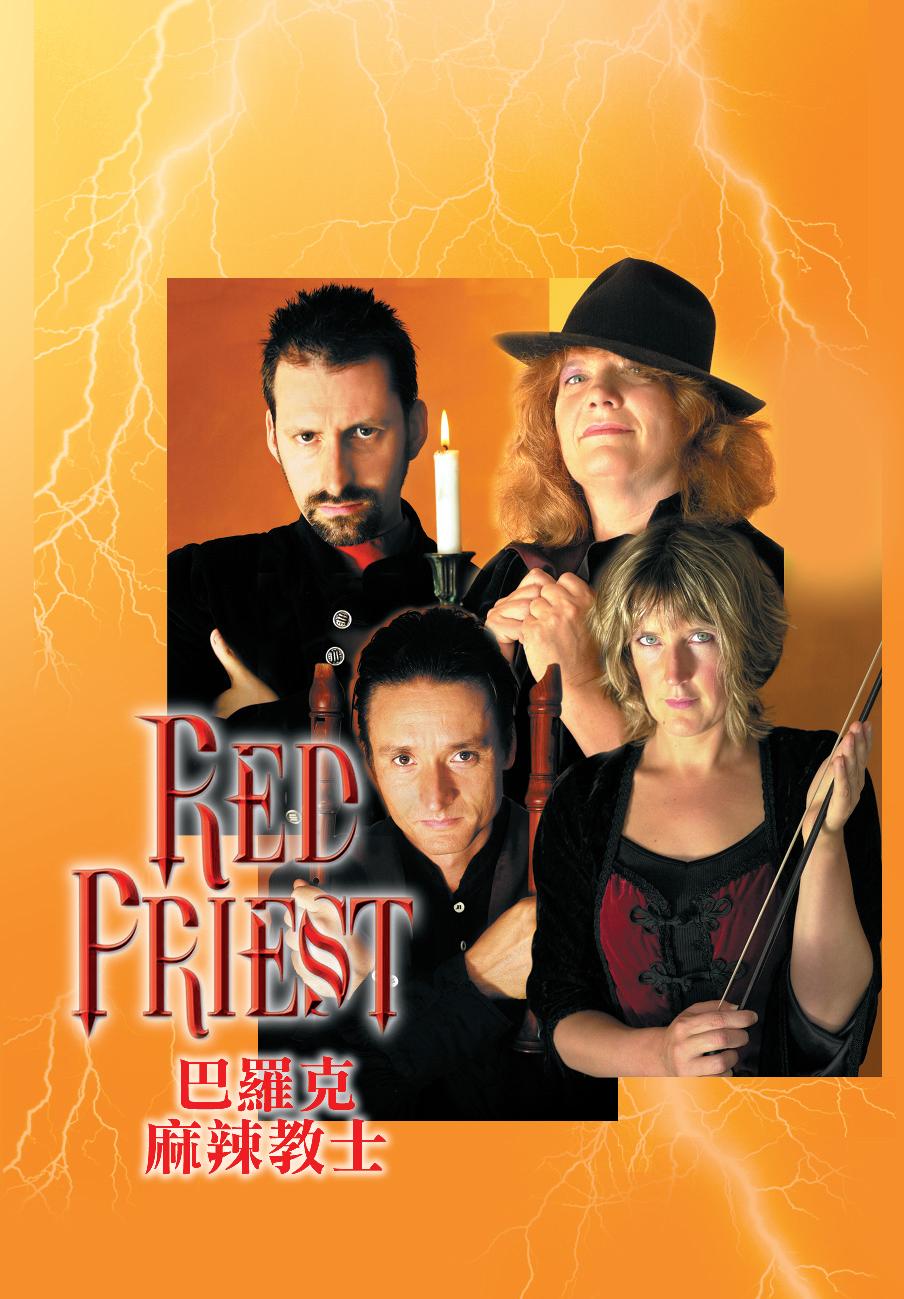

巴羅克麻辣教士 Red Priest
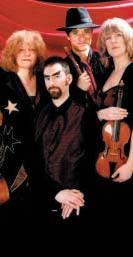
除特別註明,所有照片
Unless otherwise indicated, all photographs © John Rogers and Martin Reidl
成員名單 Ensemble
樂團介紹 Company Profile
生平介紹 Biographies
四季嘉年華 Carnival of the Seasons 曲目 Programme
樂曲介紹 Programme Notes
威尼斯惡夢:巴羅克幻想曲 Nightmare in Venice: A Baroque Fantasy
曲目 Programme
樂曲介紹 Programme Notes
音樂會前講座 Pre-concert Talk
24 and 25.2.2006 (五、六 Fri and Sat) 晚上 6:45 - 7:15pm 26.2.2006 (日 Sun) 下午 2:00 - 2:30pm
香港大會堂劇院 Theatre, Hong Kong City Hall
免費,歡迎觀眾持任何巴羅克麻辣教士音樂會門票進場 Free admission. All Red Priest concert ticket-holders are welcome.
香港大會堂劇院 Theatre, Hong Kong City Hall
演出長約1 小時40 分鐘,包括一節15
分鐘中場休息
Running time: approximately 1 hour and 40 minutes with a 15 minute interval 24 - 26.2.2006
為了讓大家對這次演出留下美好印象,請切記在節目開始前關掉手錶、無㵟電話及傳呼 機的響鬧裝置。會場內請勿擅自攝影、錄音或錄影,亦不可飲食和吸煙,多謝合作。 To make this performance a pleasant experience for the artists and other members of the audience, PLEASE switch off your alarm watches, MOBILE PHONES and PAGERS. Eating and drinking, unauthorised photography and audio or video recording are forbidden in the auditorium. Thank you for your co-operation.
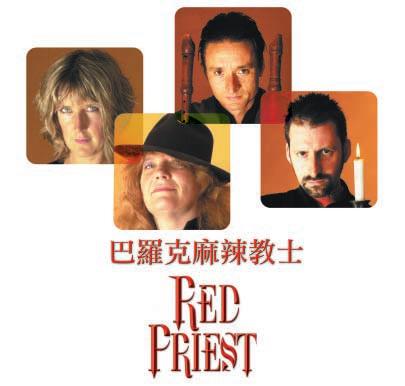
茱莉亞.畢曉普 Julia Bishop
小提琴 Violin
皮爾斯.亞當斯 Piers Adams
牧童笛 Recorders
大提琴 Cello
安潔拉.伊斯特 Angela East
古鍵琴 Harpsichord
霍華德.比奇 Howard Beach
巴羅克麻辣教士
Red Priest
以音樂家及教士韋華第命名的巴羅克麻辣教士,是當今國際樂壇演奏早期音樂最成功的組 合之一。這隊出色的英國合奏團結合驚人的技巧、豐富的感情和充滿創意的改編作品,將 演奏巴羅克音樂的藝術重新定位。樂團將大量巴羅克時期的曲目加以改編,不用讀譜,配 合即場的發揮,營造出千變萬化的色彩和感覺。
巴羅克麻辣教士於 1997 年組成,每年均在歐美及澳洲的重要場地演出。他們亦常於電視 及電台廣播中出現,並灌錄一系列的唱片。樂評人認為巴羅克麻辣教士的演出「充滿動 力」、「令人目眩」,是「完美的合作」,「充滿能量」、「亮麗及鼓舞人心」、「新鮮有趣」。樂
團如何充份表現巴羅克精神,從英國音樂學者和廣播員喬治.普拉特的話可見一斑:「如 果無人越過峰頂,我們怎會知道另一邊的風光?」
2005 年4 月,英國主要的藝術節目「南岸演出」,為巴羅克麻辣教士拍攝了一個一小時長的 特輯,紀錄了他們最新演出《麻辣巴羅克》的製作過程。
Red Priest is one of the major success stories on the international early music scene today. Named after the flame-haired priest, Antonio Vivaldi, this extraordinary English ensemble has redefined the art of baroque music performance, combining the fruit of extensive research with swashbuckling virtuosity, creative re-composition, heart-on-sleeve emotion and compelling stagecraft. The group performs largely from memory, allowing an operatic level of freedom and interaction, and its programmes are drawn from myriad baroque sources to create a kaleidoscopic range of moods and colours.
Formed in 1997, Red Priest now gives over 60 concerts a year in some of the most prestigious venues in Europe, Australia and the US, together with radio and television broadcasts and a series of CD recordings including Priest on the Run, Nightmare in Venice and The Four Seasons. International music critics have described the Red Priest style as “electrifying”, “sheer daring”, “immaculately forged”, “sonically supercharged”, “brilliant and inspired”, “deliciously twisted” but the group’s extravagantly baroque ethos is perhaps best summed up in the words of English musicologist and broadcaster George Pratt: “If nobody goes over the top, how will we know what lies on the other side?”
In Apirl 2005 Red Priest was the subject of an hour-long TV profile for the UK’s flagship arts programme, the South Bank Show, which documented the launch of their new Red Hot Baroque Show, an electrifying marriage of old music with the latest light and video technology.
P i e r s d
牧童笛 Recorders
A
a m s
皮爾斯.亞當斯
剛被華盛頓郵報推許為「當今最出色的牧童笛演奏家」, 亞當斯曾經在不
同的音樂節和主要音樂廳中演出,包括皇家節日音樂廳、威格莫爾音樂 廳和伊利莎伯女王音樂廳。他亦曾經以獨奏 家的身份參與英國愛樂樂團、英國小交響樂 團、古樂學院合奏團、新加坡交響樂團和英 國廣播公司交響樂團的演出。
亞當斯曾灌錄多張獨奏唱片,收錄作品由首 張得獎大碟的韋華第專輯到戴維.貝德福特 別為他而作的牧童笛協奏曲。另外,亞當斯 亦將大量浪漫派作品改編成獨奏曲目並灌成 唱片。
Piers Adams was recently heralded in the Washington Post as “the reigning recorder virtuoso in the world today”. He has performed in numerous festivals and at premiere concert halls throughout the world including London’s Royal Festival, Wigmore and Queen Elizabeth Halls; and as a soloist with orchestras including the Philharmonia, the English Sinfonia, the Academy of Ancient Music, the Singapore Symphony and the BBC Symphony.
Piers Adams has made several solo CDs reflecting an eclectic taste, ranging from his award-winning Vivaldi debut disc to David Bedford’s Recorder Concerto — one of many major works written for him. He has also researched, arranged and recorded a variety of romantic showpieces, which are a mainstay of his recital programmes.
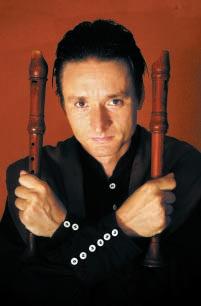
茱莉亞.畢曉普
小提琴 Violin
被英國廣播公司音樂雜誌形容為擁有「夢幻般技巧」的茱莉亞.畢曉普是 當今最傑出的巴羅克小提琴演奏家之一。畢曉普曾經在英國古樂團演出 六年,亦曾跟隨多個英國頂尖古樂團到世界 各地演出。時至今日,畢曉普經常以首席小 提琴手或獨奏家的身份演出,與著名的加布 里埃利合奏團的合作尤其緊密,並一起灌錄 唱片。
此外,畢曉普亦以獨奏家的身份與弗洛里萊
根樂團、勃蘭登堡合奏團和漢諾威樂隊合 作,並定期於英國皇家音樂學院教授巴羅克 小提琴演奏技巧。
Julia Bishop is one of the outstanding baroque violin specialists of her generation, with a virtuoso style described in the BBC Music Magazine as “psychedelic”. She has toured the world with most of the UK’s leading period instrument orchestras, including the English Concert, of which she was a member for six years.
She is now in great demand as an orchestral leader and soloist, in particular with the celebrated Gabrieli Consort, with whom she performs internationally and records. She has also appeared as concerto soloist with Florilegium, the Brandenburg Consort and the Hanover Band, and regularly teaches baroque violin techniques at the Royal Academy of Music, London.

AE n g e l a a s t
安潔拉.伊斯特
大提琴 Cello
安潔拉.伊斯特是公認的出色古樂器演奏家。《泰晤士報》讚賞她的大提 琴演奏中蘊藏着一種「自然的力量」。她曾多次在倫敦伊利莎伯女王音樂 廳及威格莫爾音樂廳演出協奏曲,並與多個 歐洲主要巴羅克樂團合作,表演獨奏和數字
低音大提琴。伊斯特曾在多個著名音樂廳舉
行獨奏會,包括史卡拉劇院、悉尼歌劇院、 凡爾賽宮和格蘭特堡歌劇院。
1991 年伊斯特成立宮廷革命樂團,以古樂器
演出歐洲革命時期的室樂作品,首八張唱片 皆獲得一致好評。
Angela East is widely respected as one of the most brilliant and dynamic performers in the period instrument world, praised in The Times of London, for the “elemental power” of her cello playing. She has given numerous concerto performances in London’s Queen Elizabeth and Wigmore Halls, and has performed as a soloist and continuo cellist with many of Europe’s leading baroque orchestras. Among her impressive list of concert credits are La Scala, Sydney Opera House, Versailles and Glyndebourne.
In 1991 Angela East formed The Revolutionary Drawing Room which performs chamber works from the Revolutionary period in Europe on original instruments, and whose first eight CDs have received glowing reviews worldwide.

HB
o w a r d e a c h
霍華德.比奇
古鍵琴 Harpsichord
霍華德.比奇多年來與不同範疇的演奏家合作,加上他作為歌唱家和小 提琴家的豐富經驗,成就了他今天全面的演奏風格。
自1989 年起,比奇與皮爾斯.亞當斯合作無 間,在音樂會及唱片中演奏古鍵琴和鋼琴, 其中包括威格莫爾音樂廳及巡迴歐洲、加拿 大和遠東的演出。他亦曾參與繁花古樂團、
阿波羅室樂團及倫敦莫扎特演奏團的演出, 作獨奏和演奏數字低音。此外,比奇常於電 台廣播中演奏,同時是英國電視台第四頻道 節目的顧問和表演者。
Howard Beach’s uniquely wide-ranging style of keyboard playing has been developed through years of partnering fine musicians in many different fields of music, as well as his own experience as an accomplished singer and violinist.
Since 1989 he has worked regularly with Piers Adams in concert and in the recording studio as both harpsichordist and pianist, including several performances in London’s Wigmore Hall and tours throughout Europe, Canada and the Far East. He has also performed and recorded as a concerto soloist and continuo player with Les Arts Florissant, the Apollo Chamber Orchestra and the London Mozart Players. Howard Beach broadcasts frequently on radio and has been a consultant and performer on programmes for the UK’s Channel 4 television.
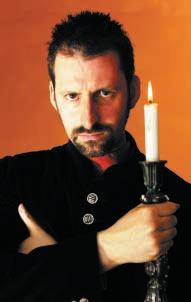
2006 年 2 月 24 日(星期五)、 2 月 26 日(星期日日場)
四季嘉年華
第一部份:春天
韋華第 (1676-1741)
E 大調協奏曲,《春天》
快板(春天來了 小鳥之歌 汩汩的溪流 雷鳴 小鳥之歌)
廣板(睡了的牧羊人 / 低語的葉和草 / 吠叫的狗)
快板(田園舞曲)
比伯 (1644-1704)
復活節奏鳴曲,《耶穌受難記》
第二部份:夏天
雲艾克 (1590-1657)
我們如何消磨這黃昏?
浦賽爾 (1659-1695)
仲夏夜之夢組曲(選自《仙后》)
序曲 仙女之舞 野人之舞 夜之追隨者之舞 夏康舞曲
韋華第
-中場休息-
G 小調協奏曲,《夏天》
不太快的快板(受炎夏煎熬之苦 布穀鳥 班鳩 紅頭金翅雀 和煦的風 北風 悲哀的農夫)
慢板 / 急板(在風暴的恐懼中睡不穩 / 蒼蠅和蚋 / 雷嗚)
急板(激烈的夏天風暴)
第三部份:秋天
巴赫 (1685-1750)
D 小調大提琴獨奏序曲
韋華第
F 大調協奏曲,《秋天》
快板(載歌載舞的農夫 酒鬼 打盹的酒鬼) 很慢的慢板(睡了的酒鬼)
快板(打獵 逃走的雄鹿 神槍手和獵犬 雄鹿死了)
約翰遜 (1583-1633)
女巫之舞
第四部份:冬天
柯里尼 (1653-1713)
G 小調大協奏曲,《為聖誕之夜而作》
極快板
極緩板
快板
慢板 / 快板 / 慢板
極快板
快板
田園舞曲
韋華第
F 小調協奏曲,《冬天》 不太快的快板(凍瘡 寒風凜冽 闊步寒風中 風 牙關打顫) 廣板(火爐旁的安靜和滿足 / 外面下着雨) 快板(冰上步步為營 跌倒 快速地跑 冰碎了 潮濕的熱風 風之戰)
所有作品均由巴羅克麻辣教士編曲
Friday evening and Sunday matinee, 24 and 26 February 2006
Carnival of the Seasons
Part One: Spring
Antonio Vivaldi (1676-1741)
Concerto in E major, La Primavera
Allegro (Spring has arrived – Birdsong – A Bubbling Stream – Thunder –Birdsong)
Largo (The Sleeping Goatherd / Murmuring Fronds and Grasses / A Barking Dog)
Allegro (Pastoral Dance)
Heinrich Biber (1644-1704)
Easter Sonata: The Crucifixion
Part Two: Summer
Jacob Van Eyck (1590-1657)
What Shall We Do This Evening?
Henry Purcell (1659-1695)
A Midsummer Night’s Dream Suite from The Fairy Queen
Prelude
Fairy Dance
Dance of the Savages
Dance for the Followers of Night
Chaconne
Antonio Vivaldi
Concerto in G minor, L’Estate
Allegro non molto (Languishing in the heat – The Cuckoo – The Turtle –dove – The Goldfinch – Balmy winds – The North Wind –The Lamenting Peasant)
Adagio/Presto (Uneasy Rest in Fear of a Storm / Flies and Gnats / Thunder)
Presto (Impetuous Summer Storm)
Part Three: Autumn
Johann Sebastian Bach (1685-1750)
Prelude in D minor for solo cello
Antonio Vivaldi
Concerto in F major, L’Autunno
Allegro (Dancing, Singing Peasants – The Drunkard – Dozing Drunkards)
Adagio molto (Sleeping Drunkards)
Allegro (The Hunt – The Fleeing Stag – Rifle-shots and Hounds –The Stag Dies)
Robert Johnson (1583-1633)
The Witches’ Dance
Part Four: Winter
Arcangelo Corelli (1653-1713)
Concerto Grosso in G minor, per la Notte de Natale
Vivace
Grave
Allegro
Adagio/Allegro/Adagio
Vivace
Allegro
Pastorale
Antonio Vivaldi
Concerto in F minor, L’Inverno
Allegro non molto (Bitter Frostbite – Cruel Winds – Stamping Feet in the Cold – Winds – Chattering teeth)
Largo (Peaceful and Content by the Fire / Rain Outside)
Allegro (Walking Cautiously on Ice – Falling Down – Running Swiftly –The Ice Breaks – The Sirocco Wind – All the Winds at War)
All musical arrangements by Red Priest

四季嘉年華
文:皮爾斯.亞當斯
作曲家的夢想肯定都是創作出一些 前所未有、家喻戶曉、足以傳世 甚至可以代表國家和整個時代的 作品。 韋華第的《四季》無疑屬於這種作 品。可是,要創作出不朽名作是要付出代 價的:對一般樂迷而言,代表作是作曲家 整個創作生涯中惟一有價值的作品,其餘 的都不值一哂。因此,一向妙語如珠的湯 瑪士.畢勤爵士不把韋華第其餘四百多首 協奏曲放在眼內,認為只是「將同一首協奏 曲重複四百次」。
的確,跟許多作曲家一樣,韋華第也寫了 不少賺快錢的作品,而且他可能過度使用 某種作曲技巧(所謂的「尾聲原理」),也經 常使用令人目眩的小提琴技巧來刺激聽眾 的反應。這些作風當時都招來詬病,有個 別音樂學者甚至不屑地認為,韋華第這個 人「天生輕浮」。一直以來,韋華第都被認 為只會寫簡單、不斷重複和聲及音型的作 品,事實並非如此,堪稱巴羅克時期其中
一首最富色彩和創造力的器樂作品的《四 季》,並非那麼的與他的其他作品不同。
重新演繹《四季》
正因為這樣,對於這個節目放棄名氣稍遜 的傑作而選擇耳熟能詳的《四季》,我們都 有幾分內疚 雖然,我們很希望新的改 編版本會給原曲帶來新的感覺。《四季》受 歡迎的原因,可能在於作品本身像在說故 事,吸引演奏者去了解音符背後的戲劇元 素;韋華第在作品附帶的十四行詩况也有 詳細列明作品的戲劇元素,這樣便確保演 出豐富多采,能吸引聽眾及表達作品的主 題,也就是所有作曲家對自己作品的期 望。事實上,所有巴羅克時期的音樂手冊 都強調在音樂中加添戲劇元素,用音符來 講故事,以豐富感情和色彩去描繪。在這 方面,《四季》也不例外,不同的只是《四 季》是當時的器樂作品中,少數以預設指引 來確保演出效果的作品。
整體而言,演奏人數越多,越難發揮修飾 技巧,很多速度、力度和情緒上的微妙變
化都很容易被掩蓋,未能增加作品的感染 力。我們這個版本將演奏人數減至最少, 希望能加強音樂的效果,重現當時意大利 鄉間的情景。為了增加趣味,我們以牧童 笛演奏主旋律,而這也是韋華第在生時一 些音樂家的做法。(法國作曲家查德費拉甚 至出版了一個改編版本,以牧童笛、小提 琴、古大鍵琴、古鍵琴和手搖風琴這個古 怪的樂器組去演奏《四季》!)
我們其餘的曲目亦以季節為主題,帶出韋 華第忽略了的一些重要日子。
奧地利小提琴大師比伯的「十五首玫瑰經奏 鳴曲」以寓言方式描述基督的故事,讓聽眾 經歷異教徒或諾斯蒂教的死亡與復活的週 期。第十首《耶穌受難記》被認為是全套作 品中最緊湊和最富戲劇性的一首,將小提 琴的技術和感情都發揮得淋漓盡致,當中 特別運用了錯誤的調弦,將小提琴最高的 琴弦由正常的 E 調調低至 D 調。
我們如何消磨這黃昏?
初夏漫長黃昏的歡愉完全表現在失明荷蘭 音樂家 雲艾克 的一組短小的牧童笛變奏曲 中。雲艾克是當時最傑出的牧童笛演奏 家,也是烏德勒支市供養的街頭藝人,他 一定曾為市內聖約翰教堂的遊客演奏過這 首作品,並成為遊人焦點。
以 浦塞爾 富夢幻氣息的歌劇《仙后》來慶祝 夏至是最好不過的。我們在這部根據莎士 比亞《仲夏夜之夢》改編而成的作品中挑選 一連串的雜錦音樂,有輕快的《仙女之 舞》,喧鬧的《野人之舞》(野人粗暴地驅趕 仙女),如幽靈般沉着的《夜之追隨者之 舞》,最後以著名的夏康舞曲(《為中華男女 而舞》)作結,把整個歌劇帶進瘋狂、愉快 的氣氛。
在異教或西方曆法中另一個重要日子就是 秋天的萬聖節。根據古老傳說,於過去一 年離世的人,他們的靈魂會在萬聖節回來 尋找活人,以在來年依附在這些人身上。
我們選了英國假面劇,充滿尖笑聲的《女巫 之舞》這首短小作品來應節。
為聖誕之夜而作 對韋華第、韓德爾和巴赫有深遠影凑的 柯 里尼 是巴羅克協奏曲的奠基者,他著名的 《為聖誕之夜而作》包括由兩個小提琴和一 個大提琴演繹的小協奏曲,以及由弦樂和 數字低音演繹的大協奏曲組成,後者主要 起襯托用,讓樂曲顯得更柔和。十八世紀 的佚名版本則以兩支牧童笛和數字低音演 繹,而多明尼高.羅西也有一個古鍵琴獨 奏版本。雖然這首作品况並沒有註明樂曲 的表達方式,但最後一章的田園曲卻是巴 羅克聖誕音樂中常見的特色,活現聖經中 牧羊人在田野的情景。

Carnival of the Seasons
by Piers Adams
To create a piece of music which achieves unprecedented, household-name popularity throughout the world, continues to live on for centuries after one’s death, and indeed becomes the defining work for a particular country and epoch, must be the dream of every composer. Vivaldi’s Four Seasons clearly fall into this elite category. And yet there’s a price to pay for such immortality: the masterpiece becomes, in the eyes of the general public, the only worthwhile work in the composer’s entire output; everything else is pre-judged as inferior. Thus Sir Thomas Beecham famously dismissed Vivaldi’s remaining 400 (and more) concertos, with a single slice of his razorsharp wit, as “the same concerto composed 400 times”.
Certainly it is true that Vivaldi wrote as did all composers his fair share of potboilers, and that he had a tendency to overuse a particular compositional technique (the so-called ‘Ritornello Principle’). He also frequently relied on the dazzling effects of his virtuosity on the violin to create the desired reaction from his audiences a fact which led one particular musicologist at the time to dismiss him as a man with “too much mercury in his constitution”. But his enduring reputation for composing only simplistic, endlessly repetitive harmonies and figurations simply does not stand up to close scrutiny, and the Four Seasons , recognised among the most colourful and inventive instrumental works of the entire

Baroque period, are far from atypical of the Red Priest’s imagination.
Re-interpreting the Seasons
It is therefore with a tinge of guilt that we have chosen in this programme to eschew Vivaldi’s lesser-known masterpieces in favour of these instantly recognisable strains — although it is hoped that our brand new arrangements will show them in a fresh light. Perhaps the principal key to the Seasons ’ popularity lies in their overtly programmatic nature, which encourages performers to look beyond the notes themselves to the dramatic possibilities behind them, as spelled out in vivid detail in Vivaldi’s accompanying sonnets. In this way, Vivaldi was merely ensuring that performances would have the full variety, interest and intent that all composers naturally wished for their works. Indeed all of the musical instructional manuals from the time stress the importance of adding drama to music, telling stories with the notes, painting a canvas of richly varied colours and emotions so, far from being the exception to the rule in terms of dramatic
possibility, the Seasons were simply one of the very few instrumental compositions of their day which gave in-built instructions for effective performance.
On the whole the larger the group of musicians, the harder it becomes to employ the rhetorical devices which can bring the musical effects to life, as these must involve many subtle changes of tempo, attack and mood which can so easily become ‘smoothed over’. In our version we have paired down the number of musicians to the minimum in order to amplify these effects, and thereby bring out to the full the sights and sounds of a year in the Italian countryside. We have, for added interest, placed the lead line onto the recorder, a practice which was adopted by some musicians in Vivaldi’s lifetime (the French composer Nicholas Chedeville even published an arrangement of the Seasons for the obscure combination of recorder, violin, viola da gamba, harpsichord and hurdy-gurdy!).
The remainder of our programme expands on the seasonal theme, bringing in a few key dates which Vivaldi neglected.
The 15 Rosary Sonatas by the eccentric Austrian violin virtuoso Heinrich Biber depict the Christian story in allegorical fashion, taking the listener through the entire Pagan/Gnostic cycle of death and rebirth. The Crucifixion Sonata, the 10th from the set, is understandably the most intense and dramatic, making full use of the violin's technical and expressive range enhanced further by use of scordatura tuning, whereby the top string is tuned to a D, a tone lower than normal.
What Shall We Do This Evening?
The lengthening evenings of early summer are captured playfully with a short set of variations for solo recorder by the blind Dutch musician, Jacob Van Eyck , the greatest recorder virtuoso of his day. Van Eyck would undoubtedly have performed
this work in the open air to the visitors of St John’s Church in Utrecht, where he was a city-sponsored busker and a major tourist attraction!
As we pass the summer solstice, what better way to celebrate than with Henry Purcell’s magical opera, the Fairy Queen, based on that most popular of Shakespearean fantasies, A Midsummer Night’s Dream? From this we perform a medley of tunes, ranging from the fleetfooted Fairy Dance to the raucous Dance of the Savages (who rudely chase the fairies away). The ghostly-calm Dance of the Followers of Night leads into the famous Chaconne (Dance for Chinese Man and Woman), which brings the whole opera to a maddeningly joyful close.
Another key date in the Christian/Pagan calendar is the autumn festival of Halloween, when, according to ancient lore, the disembodied spirits of all who have died throughout the preceding year come back in search of living bodies to possess for the next year. We celebrate this day with a short work from the English Masque repertoire, depicting hissing, cackling Witches . . .
Concerto in F minor, L’Inverno
Arcangelo Corelli was, in effect, the founder of the baroque concerto, and his music was to have a profound influence on later composers from Vivaldi to Handel and Bach. His famous Christmas Concerto is scored for a concertino group of two violins and cello, with a larger concerto grosso ensemble of strings and continuo, whose function is largely a supportive one, thus allowing an effective reduction for smaller forces. Indeed an anonymous 18th century transcription exists for two recorders and continuo, and another by Domenico Rossi, for harpsichord alone. Although there are no specifically descriptive elements to the work, its final movement is a gentle Pastorale, a common feature in baroque Christmas music representative of the biblical shepherds in their fields.
2006 年 2 月 25 日(星期六)、 2 月 26 日(星期日夜場)
威尼斯惡夢:巴羅克幻想曲
韋華第 (1676-1741)
G小調惡夢協奏曲, RV439
廣板
幽靈(急板,廣板,急板)
入夢(廣板)
追逐(快板)
仙馬 (十七世紀)
三聲部奏鳴曲
約翰遜 (1583-1633)、雷斯特朗 (十七世紀)
森林之神之假面劇
弗拉特假面劇
復仇三女神
女巫之舞
浦賽爾 (1659-1695)
二分一接近固定低音
卡撒蒂 (1620-1677)
錫非羅的固定低音
奧蒂茲 (活躍於 1550年代)
二首主題模仿曲
韋華第
D小調大協奏曲, RV565
快板
慢板及跳弓
快板
廣板
快板
-中場休息-
巴赫
大提琴第五組曲之序曲
雲艾克 (1590-1657)
英國夜鶯
塔天尼 (1692-1770)
G小調奏鳴曲,《魔鬼的顫音》
廣板
行板 / 快板 / 慢板
葛路克 (1714-1787)
幸福精靈之舞
雷克萊 (1697-1764)
魔鬼之歌及交響曲
巴羅克麻辣教士 (1997-)
柯里尼之《佛利亞舞曲》之幻想
所有作品均由巴羅克麻辣教士編曲
Saturday and Sunday evenings, 25 and 26 February 2006
Nightmare in Venice: a Baroque Fantasy
Antonio Vivaldi (1676-1741)
The Nightmare Concerto (La Notte) in G minor, RV439
Largo
Phantoms (Presto, Largo, Presto)
Sleep (Largo)
The Chase (Allegro)
Giovanni Paulo Cima (17th Century)
Sonata à Tre
Robert Johnson (1583-1633)/Nicholas Le Strange (17th Century)
The Satyrs’ Masque
The Flatt Masque
The Furies
The Witches’ Dance
Henry Purcell (1659-1695)
Two in One upon a Ground
Maurizio Cazzati (1620-1677)
Zephiro’s Ground
Diego Ortiz (fl 1550)
Two Ricercadas
Antonio Vivaldi
Concerto Grosso in D minor, RV565
Allegro
Adagio e Spiccato
Allegro
Largo
Allegro
– Interval –
Johann Sebastian Bach
Prelude from Suite No 5 for Cello
Jacob Van Eyck (1590-1657)
The English Nightingale
Guiseppe Tartini (1692-1770)
Sonata in G minor, The Devil’s Trill
Largo
Andante/Allegro/Adagio
Christophe Wilibald Von Gluck (1714-1787)
Dance of the Blessed Spirits
Jean-Marie Leclair (1697-1764)
Demon Airs and Simphonie
Red Priest (1997- )
Fantasy on Corelli’s La Folia
All musical arrangements by Red Priest
KPMG
AD 9
威尼斯惡夢: 巴羅克幻想曲
文:皮爾斯.亞當斯
直以來,威尼斯都讓人聯想到魔 法和煉金術。在文藝復興時期, 基督教傳遍歐洲,但威尼斯仍是 不成文的學習煉金術之綠洲;此外,佔有 地利的威尼斯是歐洲通往東方的貿易大 門,因此成為西方神祕傳統、伊斯蘭及東 方文化的熔爐。
十七世紀初,這種充滿濃厚創意的環境孕 育出一種風格突破的器樂音樂,而這種「荒 誕奇異風格」正標誌着巴羅克時期的誕生 (巴羅克一字本意就是古怪)。這種豐富的 音樂風格在歐洲延續了一百五十年。這晚 的節目中我們將探索它的根源和發展。韋 華第來自威尼斯,由這位正版紅褐色頭髮 教士的音樂開始不是最好嗎?
《惡夢協奏曲》叫人改觀
雖然在羅馬教會佔有重要位置,但別以為 韋華第是一個充滿傳統「教士價值觀」的神 職人員。根據記載,韋華第熱情入世,經 常出風頭,而過度世俗的事務最終亦毀掉 他的健康與財富。這位非一般的神父,他 的音樂也備受批評。雖然在他五百多首協 奏曲中,的確有一些是為生活費而寫的, 可是,要說 韋華第 不斷重複簡單的和聲及 音型,卻與事實不符。只要聽過《惡夢協奏
曲》開始的幾個小節,就會立即改觀。這首 作品就如以十八世紀為背景的《哈默恐怖之
家》的配樂,一開始時尖銳而不整齊的節 奏,帶出嚇人的氣氛,有如揭開樂曲中主 角恐怖之夜的序幕。
在第二個名為《幽靈》的樂章中,鬼魅的形 態不斷在想像中飛馳,在樂章中段稍為放 緩,陰魂不散地在上空徘徊,準備瘋狂轉 個不停;緊接的《入夢》帶來短暫的安寧, 但緩慢而刺耳的二十七個小節仍表現出被 惡夢追逐的不安,使樂曲在焦慮的氣氛中 完結。
荒誕奇異風格其中一個最早期的例子,是 米蘭風琴家 仙馬寫於 1610 年的三聲部奏鳴 曲 ,比韋華第還要早一個世紀。這首短小 的作品,將舞蹈、歌曲和歌劇元素共冶一 爐,顯出無拘無束、出乎意料的風格。現 代的聽眾慣聽更寬廣的主題發展,這首作 品可能會讓他們感不安,但可以想像,這 種戲劇化的新風格對當時的音樂家和聽眾 帶來不少刺激和啟發。
莎士比亞時代的英國,也有她音樂魔術和幻 想的傳統,尤其是當地的假面劇和帶面具的 滑稽戲,讓不可能的事都在戲劇化的神話故 事况一一成真。充斥了仙女、女巫和半人半 獸的神話劇種,在這幾首羅伯特.約翰遜及 雷斯特朗的作品中,可得明證。
文藝復興和巴羅克時期最流行的曲式是低 音變奏曲 在重複低音或和弦上發展的
變奏。英國著名作曲家 浦塞爾 曾經形容在 固定低音上創作是「一件非常容易的事」。
因此,為增添挑戰性,他在歌劇《狄歐克立 遜》中創作出繞樑三日的二分一接近固定低 音。 在這個充滿創意的作品中,兩個相隔 二小節的高音旋律以輪唱形式出現在六小 節的固定低音上。
卡撒蒂的固定低音 卡撒蒂的《錫非羅的固定低音》則更加活 潑,高音線條彷如在輕鬆愉快的低音上起 舞。當時很多作曲家均採用這種手法,最 有名的是蒙台威爾第名曲《錫非羅回來》。
著名的古提琴家 迪亞戈.奧蒂茲 在演奏固 定低音上多聲部的技術超群,是少數可與 意大利人分庭抗禮的西班牙人。這次介紹 的兩首 主題模仿曲 原本是為古提琴與古鍵
琴而作的,但我們將第二首的旋律改以牧 童笛為主,並加上小提琴和低音的聲部。
結束音樂會上半場的作品是韋華第作品3協 奏曲集《和諧的靈感》內的「D小調大協奏 曲」,這首作品沒有《惡夢協奏曲》那麼「荒 誕」,但創意不減。此作品本為以兩個小提 琴、一個大提琴和弦樂隊演奏而作,但要 改編成為較小型樂團的樂曲也毫無困難, 巴赫甚至將此作品改編成管風琴獨奏曲, 效果非常出色。這首作品再次顯現韋華第 式魔法般的才能 開始時是突出的重複 樂段,中段採用賦格曲式,接着的樂章是 優美的威尼斯西西里舞曲,而最後則是典 型的韋華第式快板,在持續低音上營造戲 劇性的高潮。

水、火、土和空氣是煉金術的四大元素, 正好與我們的四種樂器成類比。大提琴那 種質樸如土的音色,在 巴赫 的大提琴組曲 中得到充分發揮:巴赫精通命理學和幾何 學,這况選的 大提琴第五組曲之序曲 ,有
超凡脫俗之感。代表空氣的樂器當然是牧 童笛,而失明的荷蘭牧童笛演奏家 雲艾克 的作品則是代表,他把流行曲和器樂旋律 重新演繹,如《英國夜鶯》,耳邊彷彿傳來 希臘神話况牧羊神的笛聲。
小提琴則充當火的角色,因為在文學及其 他藝術作品中,這件樂器都與地獄火光中 的魔鬼聯繫在一起。 塔天尼的《魔鬼的顫 音》奏鳴曲相傳真是塔天尼在夢中,看着床 尾的魔鬼以「難以置信、超凡卓越的技術」 演奏小提琴。古鍵琴正好代表水,音色像 水中泛起的漣漪,伸延到每一個角落,使 音樂結構顯得更細密。
《幸福精靈之舞》
來到了巴羅克後期的作品。 葛路克 的歌劇 《奧爾菲斯》中《幸福精靈之舞》是有史以來 最著名的長笛樂段之一。有些音樂學者認 為這首動聽、扣人心弦的作品其實是為當 時已不流行的牧童笛而寫的,因此很能發 揮牧童笛的音域和音色。
十八世紀的法國音樂可能略欠激情,卻以 精巧、細緻結構和優雅的風格聞名。當時 只有少數作曲家能結合這種誘人的法國風 格和炫燿華麗的意大利學派特色, 雷克萊 是其中之一,他更是一個優秀的小提琴 家。這種融合的音樂風格,在他惟一的歌 劇作品《西拉與格勞庫斯》內的《魔鬼之歌》 和劇終的 交響曲 中發揮得淋漓盡致。在改 編這些舞曲時,我們因應需要,把法國音 樂况典型的兩個中提琴改為一個小提琴,
加上我們的材料,創作出豐富而有民歌味 道的聲部,讓牧童笛的旋律在其中飛翔。
《佛利亞舞曲》的真正巴羅克精神 音樂會壓軸的作品是最能發揮我們想像力 的《佛利亞舞曲》 一首源自十六世紀葡 萄牙、有十六小節固定低音的樂曲。
「Folia」在葡萄牙語原意是愚蠢、瘋狂。創 作這旋律的不知名作曲家應該可以得到為 數不少,卻從未收過的版稅,因為這調子 後來成為由韋華第到拉赫曼尼諾夫等很多 偉大作曲家的變奏曲的固定低音。
其中最著名的一首是意大利小提琴家 柯里 尼 寫於 1700 年前後的小提琴奏鳴曲集(作 品 5)中的最後一首,後來更改編為一個牧 童笛和數字低音的版本。我們就以這個版 本為骨幹,加進小提琴第二聲部,並讓其 他新材料隨意穿插,得到的狂野音樂效果 未必就是大家認為「真確」的版本,但我們 希望它能表現出真正的巴羅克精神。
Nightmare in Venice: A Baroque Fantasy
by Piers Adams
The city of Venice has long been associated with magic and alchemy. Throughout the Renaissance it remained an unofficial oasis of hermetic study and practice in an otherwise Christianised Europe, and through its prominent position as a trading gateway to the East it became a melting pot of western mystery traditions and Islamic and Oriental culture.
It was into this richly creative environment that an extraordinary new style of instrumental music emerged at the turn of the 17th century, referred to as the Stilus Phantasticus (Fantastic Style) — which, in effect, marked the beginning of the Baroque era (the word ‘baroque’, in its original context, meaning simply ‘strange’ or ‘bizarre’). Our programme explores both the roots and the subsequent development of this extravagant musical style throughout Europe over 150 years. And where better
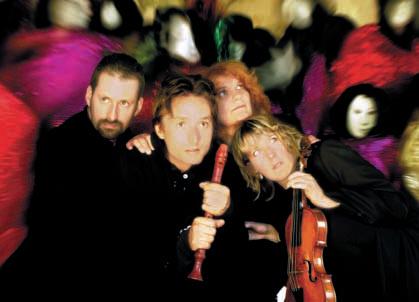
to start than with the original Red Priest of Venice himself, Antonio Vivaldi?
The Nightmare Concerto
Despite his prominent position in the Roman church, it would be quite erroneous to imbue Vivaldi with traditional ‘priestly’ values indeed he was by all accounts a hot-blooded showman and a man of extravagance in all worldly things, which eventually were to destroy both his health and his wealth. His music is likewise frequently misrepresented. While he undoubtedly wrote a number of ‘potboilers’ among his 500 or so concertos, his enduring reputation for composing only simplistic, endlessly repetitive harmonies and figurations simply does not stand up to close scrutiny, and is instantly dispelled in the first bars of his Nightmare Concerto a kind of 18th century Hammer House of Horror movie-score, with jagged rhythms leading into a menacing pulse as the concerto’s imaginary protagonist begins a night of terror.
The second movement is entitled Fantasmi (Phantoms) : ghostly figures which hurtle through the imagination, pausing to hover menacingly in the movement’s central oasis before whirling frenziedly onwards. A brief period of calm follows in Il Sonno (The Sleep) but the 27 slow measures of discord suggest a deep unease before the nightmarish chase resumes to bring the concerto to its disturbing conclusion.
One of the very earliest examples of the ‘Stilus Phantasticus’ is the Sonata à Tre by the Milanese organist Giovanni Paulo Cima , composed a century before Vivaldi’s day, in 1610. In this short piece
elements of dance, song and operatic gesture are combined in a freewheeling, unpredictable fashion. The overall result may be unsettling to modern musical ears, used as they are to broader thematic development, but one can imagine the excitement that this dramatic new style would have inspired amongst musicians and listeners of the day.
Shakespearean England too was home to its share of musical magic and fantasy especially in the masque and antimasque tradition, where the impossible was made possible in the dramatisation of mythological tales; mystical characters abound, and the genre is richly laced with fairies, witches and satyrs, represented here in a set of pieces by Robert Johnson and the aptly-named Nicholas Le Strange.
...upon a Ground
One of the most popular musical forms throughout the Renaissance and Baroque eras was that of the ground bass: variations composed over a repetitious bass lines or chord sequence. The great Henry Purcell once said that composing on a ground is ‘a very easy thing to do’, and so set out to make life a little more challenging with the haunting Two in One upon a Ground, from his opera Dioclesian. In this ingenious work the two treble lines follow each other canonically, two bars apart over the six bar bass.
Maurizio Cazzati’s Ciaconna (Zephiro’s Ground) is an altogether more lively affair, the upper lines dancing over a particularly jaunty bass riff, used by many composers of the time, notably Claudio Monteverdi in his celebrated song, Zephiro Torna. Diego Ortiz was a renowned player of the viol ,
the only Spaniard to rival the Italians at the art of performing divisions over a ground bass. The two linked Ricercadas presented here were originally composed for a single viol and harpsichord, but in the second we have transferred the melody to the recorder and added our own parts for violin and bass.
Less ‘fantastical’ in theme than the Nightmare Concerto but certainly no less inventive is Vivaldi’s Concerto Grosso in D minor , from his celebrated Opus 3 set of concertos entitled L’Estro Armonico (The Harmonious Fancy), which concludes the first part of our concert. This popular work was scored for two violins, solo cello and string orchestra, but also arranges comfortably for smaller ensemble; J S Bach even transcribed it most successfully for solo organ. This is another fine example of Vivaldian wizardry, from the spectacular opening riffs to the formality of the central fugue. The penultimate movement is a beautiful Venetian sicilienne, and the finale a typically full-blooded Vivalidian allegro with a dramatic climax over a pedal bass.
As the four elements Earth, Air, Fire and Water form an integral part of the hermetic worldview, we could not resist making a comparison with the four elements of our ensemble. The Earthy tones of the cello are given their most complete expression in the suites of Bach a composer who fully understood the inner mysteries of sacred numerology and geometry represented here in the otherworldly prelude to the fifth suite. The recorder clearly is the instrument of Air, no better represented than in the music of the
blind Dutch recorder player Jacob Van Eyck, who transformed popular song and instrumental tunes such as The English Nightingale into true Arcadian fantasies, conjuring images of Pan.
The violin takes the role of Fire through its associations in art and literature with the Devil in the fires of Hell. Guiseppe Tartini’s Devil’s Trill sonata came to the composer quite literally in a dream, in which the Devil stood at the foot of the bed and played to him on the violin “with such mastery and intelligence, on a level I had never before conceived was possible”. The harpsichord represents Water, rippling through and filling the holes in the musical texture throughout.
Dance of the Blessed Spirits
We now reach the furthermost limits of the Baroque era, and one of the most famous and magical flute solos of all time Gluck’s Dance of the Blessed Spirits , from Orpheo. Some musicologists believe that this haunting and beautiful work was actually intended for the by then out-offashion recorder, so well does it fit the range and timbre of that instrument.
French music of the 18th century is perhaps known less for bursts of fire and fancy than for a cultured, subtle refinement, nuance and delicate ornamentation. Jean-Marie Leclair , however, was one of the few composers of his day who successfully combined this sensual style with the flamboyance of the Italian school (in which he had trained as a virtuoso violinist) a synthesis which is superbly displayed in the Demon Airs and concluding Simphonie from his only operatic work, Scylla et
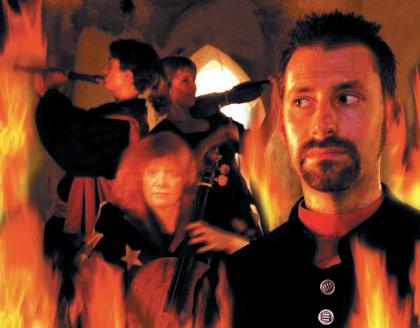
Glaucus. In arranging these dances it was necessary to compress the typically French sound of two violas onto a single violin, adding some of our own material to create a rich, folksy cushion of sound over which the recorder’s tune can fly.
Fantasy on Corelli’s La Folia
And so to the conclusion, and the final unleashing of our musical imaginings. La Folia literally a folly, or even, madness began life as a 16-measure ground (melody and bass), composed sometime in the 16th century in Portugal. Whoever wrote it should have posthumous claim to some substantial, overdue royalty payments, as the tune was to become one of the most enduring and widely used of
all grounds, subjected to expansion and variation by composers from Vivaldi to Rachmaninov and beyond.
One of the most famous sets of Folia variations was written by the celebrated Italian violinist Arcangelo Corelli sometime around the year 1700, as the conclusion to his Op 5 set of violin sonatas, and later arranged for recorder and continuo. It is this latter version that we have used as a framework for ours, adding a second part for the violin and freely infiltrating our own material throughout. While the resulting musical madness may not fit the currently accepted boundaries of ‘authenticity’, we hope that it is taken in the truly baroque spirit with which it is intended...
